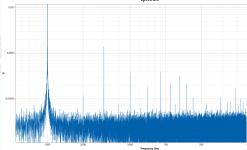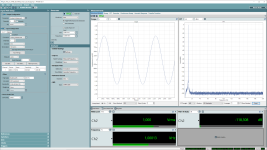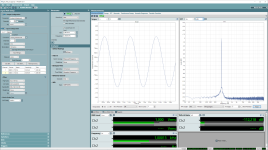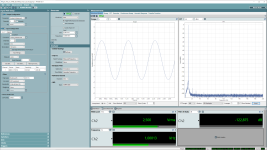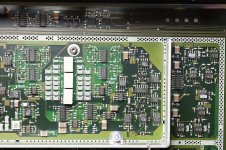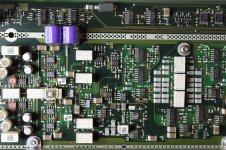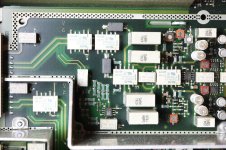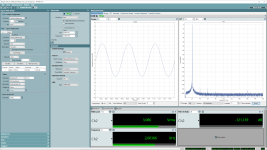The QA401 does 3.5 ppm on a good day which is pretty good for a 400 buck machine. I haven’t looked at the 403, but with a bit of effort, it’s not going to be nipping at AP’s heals but taking chunks out of AP’s calves performance wise. That said, the AP logo does give it cred - an issue Matt and co will have to address.
Private Equity. Don’t get me started . . .
Private Equity. Don’t get me started . . .
replying to a way earlier post....
here's what the percent view of spectral plots shows (zoomed in). It's a nice way to validate where your distortion is coming from visually.
I'm still working on the data summary boxes. They're kind of useful placeholders at the moment and they need better formatting (like uV display), ability to show dBV rather than V, and some of the math is just plain wrong. When I finish the last 'urgent' piece (impedance testing) I'm planning to go back and update all the summaries to better usage then put the app dev on napping for a while.
Mark
here's what the percent view of spectral plots shows (zoomed in). It's a nice way to validate where your distortion is coming from visually.
I'm still working on the data summary boxes. They're kind of useful placeholders at the moment and they need better formatting (like uV display), ability to show dBV rather than V, and some of the math is just plain wrong. When I finish the last 'urgent' piece (impedance testing) I'm planning to go back and update all the summaries to better usage then put the app dev on napping for a while.
Mark
Attachments
I wish I could afford a UPV right now. I would have been all over it.
Mind you, the RTX is better than most of what I measure, so ...
Mind you, the RTX is better than most of what I measure, so ...
You can see some plots here: https://neurochrome.com/pages/measuring-distortion-on-the-cheap. The test setup is noted in the graph titles.At what voltage / frequency? Is this 2VRMS / 1KHz / 20-20K?
I believe the spec is -117 dB THD+N. Typical performance is <-120 dB THD+N. That's almost entirely due to the ~1.0 µV RMS input noise and the 20 kHz BW, though. And yes. Anything below -120 dB THD+N is a nice bonus.My understanding is that AP guarantee the 555 to have -120dB THD+N
I find it super odd that they don't specify the THD with the advanced sine analyzer (notch filter + gain + magic - see Archimago's article for details) as that's the real value-add of the 555 over the 525. The THD+N of the 555 is ~4 dB better than the 525. Whoopti-f'ing-doo! But the THD is almost 40 dB better and that is seriously impressive. Those are not 40 "easy" dB to get. So I honestly think they're missing a marketing opportunity here. Maybe they should move on that and charge even more... 😉
Making that tuneable notch filter in the "advanced sine analyzer" must have taken some cleverness.
Because audio is fun. You could just as easily ask, "why is Tom wasting his life running Neurochrome when he could be making 2-3 times as much working for someone else?" I'm not joking about the 2-3x factor, by the way. I would rather have the freedom that I currently have than the money.If you have the chops to design something that will outperform the 555 why would you focus on audio, when there is far more $$$ to be had in RF?
Tom
Last edited:
didn't know bruce had retired ... good for him
does samuel design for R&S now? i missed why he was mentioned ...
does samuel design for R&S now? i missed why he was mentioned ...
You can see Samuel's about page here: https://www.nanovolt.ch/about_me/index.html
I only mentioned him because he's one of the very few to have emerged in the audio test / objective field in the last few years. Most of the engineers that I can think of in that area are retired. If R+S took him on to design a new AA, there's no doubt in my mind that it would outperform the 555. Alas, I think there are greater chances of hell freezing over than that happening. R+S are focused very much in the $$$ RF area.
I only mentioned him because he's one of the very few to have emerged in the audio test / objective field in the last few years. Most of the engineers that I can think of in that area are retired. If R+S took him on to design a new AA, there's no doubt in my mind that it would outperform the 555. Alas, I think there are greater chances of hell freezing over than that happening. R+S are focused very much in the $$$ RF area.
Because audio is fun
Good for you. I think you'll find that for many the fun is inversely related to how great the impetus to pay rent / bring up kids / have regular holidays is. I can think of gifted engineers who have a lot of fun with audio at weekends, but during the week they work in RF as it provides a much better living. I found that making music was an awful lot of fun, until I had to think about bringing in a certain amount each week to pay bills, whereupon it pretty much became like any other job. I don't get to work in the studio these days, but my enjoyment of music is greater than it ever was, as I don't have pressure to crank out work. A producer remarked to me recently 'you really need to get back in the studio'. I think he realised that I was living vicariously through working with him...
Hello thermionic,
two months ago an oscillator I developed was measured with an APX555. (see thread Low-distortionAudio-range Oscillator page 506ff.) For comparison I have the performance of the APX 555 for 1V, 2V, 2.5V and 3V RMS. (see pictures...)
Best regards
Helmut Sell
two months ago an oscillator I developed was measured with an APX555. (see thread Low-distortionAudio-range Oscillator page 506ff.) For comparison I have the performance of the APX 555 for 1V, 2V, 2.5V and 3V RMS. (see pictures...)
Best regards
Helmut Sell
Attachments
I'm trying to guess which post you're referring to and, thus, which oscillator you're referring to. A link to the appropriate post would be more useful. I'm guessing you're talking about Victor's oscillator. It's a good oscillator in spite of its quirks (single supply, long settling time on the amplitude, slight frequency wander). But note that the oscillator in the AP (and the notch filter in the advanced sine analyzer) delivers stellar performance across a very wide range. Not just a single frequency.
Tom
Tom
Good work, Helmut.
Did you say in another thread that the oscillator is based around the Wein Bridge type used in the HP 339A? I have a 339A and would be very interested in modifying it if so...
Did you say in another thread that the oscillator is based around the Wein Bridge type used in the HP 339A? I have a 339A and would be very interested in modifying it if so...
There seems to be a handful of excellent oscillators out there now. I suspect that the big challenge for making a 555 killer will be the front end (don't tell me to get a Cosmos - it has a 200R input Z).
I have taken shots of a - rather dusty, sorry - UPV input channel - see attached. I took them a few moments ago and haven't digested them yet. I see AD797 and OPA627. I would have to trace it out in order to figure out what goes where... I am thinking that the ADC is likely to be the limiting factor in the UPV. You might be able to nibble a dB or so by improving the PSU or PSRR, but for headline THD+N a newer ADC may well be needed. I haven't had a chance to work out where the ADC is yet... I am going to post the photos and see what you think.
(there is an almighty kludge in this UPV that I don't see in others... I don't think this looks 'factory'... I am intrigued, as to my knowledge, no one outside of R+S has schematics. The SM has over 400 pages but no schematics...)
(it's good kludging, no? I'd be proud of that!)
I have taken shots of a - rather dusty, sorry - UPV input channel - see attached. I took them a few moments ago and haven't digested them yet. I see AD797 and OPA627. I would have to trace it out in order to figure out what goes where... I am thinking that the ADC is likely to be the limiting factor in the UPV. You might be able to nibble a dB or so by improving the PSU or PSRR, but for headline THD+N a newer ADC may well be needed. I haven't had a chance to work out where the ADC is yet... I am going to post the photos and see what you think.
(there is an almighty kludge in this UPV that I don't see in others... I don't think this looks 'factory'... I am intrigued, as to my knowledge, no one outside of R+S has schematics. The SM has over 400 pages but no schematics...)
(it's good kludging, no? I'd be proud of that!)
Attachments
Not a lot wrong with the NE5534 either, but in this application, maybe replacing a couple in the right places might improve performance.
Hello tomchr,
The five images in this thread are loopback measurements of the APX555 from the engineering firm Dr. Jordan Design (Dresden, Germany). Anyone who has developed something can have their device measured there. That's what I did. The measurements in the Low Distortion Oscillator thread therefore refer to an oscillator "I developed myself" with five switchable frequencies: 1, 2, 3, 4, and 5 kHz. I then posted two images there. One is my oscillator at 2 kHz, measured with the APX555, and the other is the loopback of the APX555 at 1 kHz. I've been developing oscillators for over 10 years (as a hobby). The oscillator I measured here, which I developed, is a State Variable Oscillator. It has nothing to do with the Victor Oscillator. Here are the two images again.
Best regards,
Helmut Sell
The five images in this thread are loopback measurements of the APX555 from the engineering firm Dr. Jordan Design (Dresden, Germany). Anyone who has developed something can have their device measured there. That's what I did. The measurements in the Low Distortion Oscillator thread therefore refer to an oscillator "I developed myself" with five switchable frequencies: 1, 2, 3, 4, and 5 kHz. I then posted two images there. One is my oscillator at 2 kHz, measured with the APX555, and the other is the loopback of the APX555 at 1 kHz. I've been developing oscillators for over 10 years (as a hobby). The oscillator I measured here, which I developed, is a State Variable Oscillator. It has nothing to do with the Victor Oscillator. Here are the two images again.
Best regards,
Helmut Sell
Attachments
Hello thermionic,
The oscillator I developed is a "state variable" type. This is primarily because it allows for much better multi-frequency realization. The oscillator I developed, which was measured by the engineering firm Dr. Jordan Design using the APX555, has 5 switchable frequencies (1-2-3-4-5 kHz). I also developed one with 10 and 20 frequencies (switchable via relay).
Regarding R&S: I have a UPL at home (from Hifi Knopf Düsseldorf). But you can't make precise measurements with a THD < -120 dB with that thing. If you measure an oscillator with a THD < -140 dB there, channel 1 will show -130 dB and channel 2 -128 dB. So, about 15 dB or more off. The UPV's I've seen at Hifi Knopf don't do much better either. R&S no longer sells audio analyzers. They make a lot of money in the RF sector. They don't need the audio stuff anymore.
Best regards,
Helmut Sell
The oscillator I developed is a "state variable" type. This is primarily because it allows for much better multi-frequency realization. The oscillator I developed, which was measured by the engineering firm Dr. Jordan Design using the APX555, has 5 switchable frequencies (1-2-3-4-5 kHz). I also developed one with 10 and 20 frequencies (switchable via relay).
Regarding R&S: I have a UPL at home (from Hifi Knopf Düsseldorf). But you can't make precise measurements with a THD < -120 dB with that thing. If you measure an oscillator with a THD < -140 dB there, channel 1 will show -130 dB and channel 2 -128 dB. So, about 15 dB or more off. The UPV's I've seen at Hifi Knopf don't do much better either. R&S no longer sells audio analyzers. They make a lot of money in the RF sector. They don't need the audio stuff anymore.
Best regards,
Helmut Sell
Hi Helmut,
If you ever decide to offer your SVO as a product or PCB, please let me know!
edit - I just looked at Knopf's website. They seem to have about a hundred AAs of all types, R+S and AP. I wonder why anyone needs that many? Do they rent them to people?
If you ever decide to offer your SVO as a product or PCB, please let me know!
edit - I just looked at Knopf's website. They seem to have about a hundred AAs of all types, R+S and AP. I wonder why anyone needs that many? Do they rent them to people?
Hi thermionic,
Yes, Karl Knopf has a lot of UPL, UPV, and Audio Precision Analyzers. I believe he also offers a 6-month value guarantee. If you don't like the device, you can exchange it for another one and get the full purchase price credited. I don't know if he also rents out devices. You can call or email him. He's usually very friendly when he's not busy.
I'm still considering further developing and improving the SVO. But that's ultimately a matter of time. I can, of course, let you know if I decide to sell the SVO.
Best regards,
Helmut Sell
Yes, Karl Knopf has a lot of UPL, UPV, and Audio Precision Analyzers. I believe he also offers a 6-month value guarantee. If you don't like the device, you can exchange it for another one and get the full purchase price credited. I don't know if he also rents out devices. You can call or email him. He's usually very friendly when he's not busy.
I'm still considering further developing and improving the SVO. But that's ultimately a matter of time. I can, of course, let you know if I decide to sell the SVO.
Best regards,
Helmut Sell
HP did that in the 8903A/B/E as well.The oscillator I developed is a "state variable" type.
Tom
- Home
- Design & Build
- Equipment & Tools
- Measuring Distortion on the Cheap
